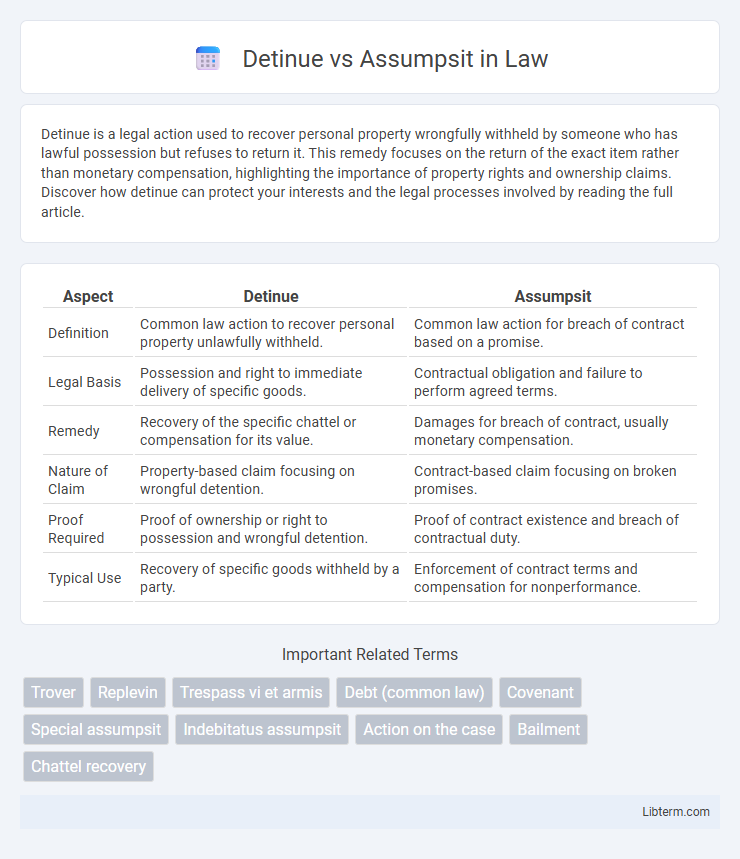Detinue is a legal action used to recover personal property wrongfully withheld by someone who has lawful possession but refuses to return it. This remedy focuses on the return of the exact item rather than monetary compensation, highlighting the importance of property rights and ownership claims. Discover how detinue can protect your interests and the legal processes involved by reading the full article.
Table of Comparison
| Aspect | Detinue | Assumpsit |
|---|---|---|
| Definition | Common law action to recover personal property unlawfully withheld. | Common law action for breach of contract based on a promise. |
| Legal Basis | Possession and right to immediate delivery of specific goods. | Contractual obligation and failure to perform agreed terms. |
| Remedy | Recovery of the specific chattel or compensation for its value. | Damages for breach of contract, usually monetary compensation. |
| Nature of Claim | Property-based claim focusing on wrongful detention. | Contract-based claim focusing on broken promises. |
| Proof Required | Proof of ownership or right to possession and wrongful detention. | Proof of contract existence and breach of contractual duty. |
| Typical Use | Recovery of specific goods withheld by a party. | Enforcement of contract terms and compensation for nonperformance. |
Introduction to Detinue and Assumpsit
Detinue is a common law action for the wrongful detention of goods, requiring the plaintiff to prove lawful possession and the defendant's refusal to return the items. Assumpsit is a contract-based action arising from a breach of a promise, either express or implied, involving the recovery of damages for non-performance. Both remedies address personal property disputes but differ in their legal basis and proof requirements.
Historical Background of Detinue
Detinue originated as a common law action during the medieval period to recover personal property unlawfully detained by another party. This remedy emphasized the defendant's wrongful detention without necessarily implicating direct conversion or deceit, reflecting the legal distinctions in property rights and possession of that era. Over time, detinue evolved alongside other personal property actions, including assumpsit, which focused more on contractual breaches rather than physical possession.
Historical Background of Assumpsit
Assumpsit originated in English common law during the 14th century as a remedy for breaches of informal promises not covered by formal contracts, evolving to address cases where no formal agreement existed yet one party suffered damages from another's failure to perform. Unlike detinue, which focuses on the wrongful detention of personal property, assumpsit expanded legal recourse by covering breaches of implied contracts based on promises and expectations. This development marked a significant shift towards recognizing personal obligations and contractual liability beyond physical possession disputes.
Key Legal Definitions
Detinue is a legal action focused on the wrongful detention of personal property, where the plaintiff seeks the return of the specific item, emphasizing the right to possession. Assumpsit, on the other hand, is centered on the breach of a contractual promise, involving a claim for damages due to non-performance or failure to fulfill an agreement. The primary distinction lies in detinue addressing the recovery of a specific chattel wrongfully held, while assumpsit concerns enforcing obligations and recovering losses from breached contracts.
Core Differences: Detinue vs Assumpsit
Detinue involves the wrongful detention of goods where the plaintiff seeks the return of specific property, emphasizing possession rather than monetary compensation. Assumpsit is based on a breach of contract or a failure to perform a promised act, focusing on recovering damages for loss caused by non-performance. The core difference lies in detinue addressing wrongful possession while assumpsit concerns contractual obligations and damages.
Typical Scenarios for Detinue Claims
Detinue claims typically arise when a person wrongfully retains possession of another's goods after lawful possession was originally granted, such as in bailment or lending arrangements. Common scenarios include disputes over unreturned leased equipment, valuables held by a third party, or goods mistakenly delivered but not returned. The claim focuses on the recovery of specific items or their value, distinguishing it from assumpsit, which involves claims for damages due to breach of contract rather than possession.
Common Applications of Assumpsit
Assumpsit is primarily used in contractual disputes where a party seeks compensation for failure to perform an agreed-upon obligation, often involving services or goods. Common applications include claims for payment under contracts, recovery of money lent, and enforcement of quasi-contractual duties such as unjust enrichment. Unlike detinue, which involves the wrongful detention of goods, assumpsit addresses breaches related to promises and agreements.
Remedies Available in Detinue Cases
Detinue primarily provides remedies focused on the return of specific goods or their equivalent value, emphasizing the recovery of possession rather than mere compensation. Courts may award damages for the detention period and any loss in value or harm caused by the withholding of the chattel. Unlike assumpsit, which addresses breaches of contract and seeks monetary damages, detinue remedies ensure restoration of possession or compensation tied directly to the property's wrongful detention.
Remedies Available in Assumpsit Cases
Assumpsit cases primarily provide remedies through monetary damages aimed at compensating the plaintiff for losses resulting from a breach of contract or failure to perform a promised act. Unlike detinue, which typically seeks the recovery of specific chattels or their value, assumpsit allows claimants to recover damages representing the actual financial harm suffered. Courts often award compensatory damages in assumpsit to restore the injured party to the position they would have been in had the contract been fulfilled.
Modern Relevance in Common Law Practices
Detinue and assumpsit remain relevant in modern common law by addressing distinct claims: detinue focuses on the wrongful retention of personal property, while assumpsit covers breaches of contract involving promises or agreements. Courts continue to apply detinue to recover specific goods wrongfully withheld, preserving property rights, whereas assumpsit underpins many contractual disputes by enabling recovery of damages for non-performance. Understanding the nuances between these actions helps legal professionals effectively navigate property recovery and contract enforcement issues in contemporary litigation.
Detinue Infographic

 libterm.com
libterm.com